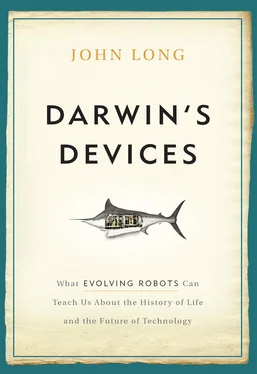Giddiness gave way to the not harsh but practical realities of scientific research. Working in Wainwright’s lab, I spent the next five years chasing after the elusive blue marlin, literally and figuratively. I wanted to measure their vertebral column’s mechanical properties, features like stiffness—related to how much the vertebral column would resist the magnitude of bending and how much spring energy it would store—and energy loss—related to how much the vertebral column would resist the speed of bending and how much energy would be lost as heat. If stiffness is large compared to energy loss, the backbone would be a spring; if the stiffness is relatively small compared to energy loss, the backbone would work as a brake. If I could measure stiffness and energy loss of the vertebral column over a range of motions and speeds, I knew that I could have some idea of what Wainwright calls “mechanical design”—in this case how the mechanical properties of the vertebral column allow it to operate as the blue marlin swims or leaps.
Unable to buy an off-the-shelf marlin-testing machine (they don’t exist), I had to design, build, and calibrate a customized vertebral column bender. My DIY guru for this challenge was Steven Vogel, also at Duke, who helped me brainstorm designs and taught me the difference between a DC brushless motor and a servo one. Once I had a working bending machine in place, Block and Wainwright helped get me and my machine out to the big island of Hawaii and the Pacific Gamefish Research Foundation.
On the Kona side of the island deepwater blue marlin are caught by recreational fishers literally in sight of the steep-sloped volcanic beaches, where, hat in hand, I would beg at the local fish houses for the castaway vertebral columns. Once I had one, I was unable to sleep until I had put each individual motion segment, consisting of two vertebrae and the intervening joint, through a series of mechanical tests. I’d bend the segments with varying frequency and amplitude, just like the marlin would have done as it hit the turbo button to pursue a tuna. To get a sense of what parts of the bone and joint structure helped cause changes in stiffness and energy loss along the column, I also measured the size and shape of each joint and the adjoining vertebrae. Lather, rinse, repeat. After several weeks I had tested the vertebral columns from six different marlin ranging in length from four to seven feet and weighing from thirty-six to more than two hundred pounds.
THE MECHANICAL DESIGN OF THE MARLIN’S BACKBONE
Back at Duke I began running the raw data through the Newtonian equations of motion that govern the relation between the bending motions the machine imposed on each joint and the bending torque each joint developed in resistance to that imposed motion. Looking over the range of joint positions, bending frequencies, and amplitude, I began seeing some very interesting patterns. The biggest surprise was that the tail, which looks from the video we took of marlin swimming to be the most flexible part of the body, actually has the stiffest part of the vertebral column. Talking with Wainwright, we realized that this was a counterintuitive result only because we were thinking of a jointed column as a series of bony blocks and frictionless hinges. If instead the joints—the hinges—were very stiff because of all of the overlapping bits of bone that Block had talked up, then the joints themselves appeared to be capable of storing energy as they bend.
But were those same joints able to release that spring energy as they unbent? This is where the energy loss came into play, and the marlin played a trick on us again. With simple ideas of springs in our heads, we had been thinking that as the marlin swam faster, increasing the frequency of their tail beats, their vertebral column would become even more spring-like, storing and releasing more elastic energy to match the power that the faster speeds demanded. We expected stiffness to increase and the energy loss to decrease. Just the opposite occurred.
To make sense of these surprises in the biological context of the swimming marlin, we put this information about mechanical properties into a mental, conceptual model of what we thought might be going on inside the marlin. Our guess was that as marlin increased swimming speed, the vertebral column would be adjusting its mechanical behavior, switching gradually from a spring to a spring with a brake. This spring-and-brake mechanism is exactly how the shock absorbers in your car work, with the spring resisting the initial bump, giving way gently, and then returning the wheel to its place on the road. At the same time, the brake, or what we call a dashpot in a shock absorber, uses fluid to dampen the spring’s motion, keeping the spring from bouncing the car vertically after that first bump.
Sounds reasonable, doesn’t it? We’ve only one problem: a backbone in my machine doesn’t necessarily act like one in a dynamically operating animal. That problem is what drove us to Hawaii in search of underwater footage of swimming marlin. We wanted to see how living marlin moved their bodies, how fast they beat their tails, and how much they bend their backbones. Knowing this would let us make a good guess about how the vertebral column is operating during swimming, but it still wouldn’t let us measure the backbone directly as it bent nor evaluate how the muscles responsible for driving the bending do their work. Nor, for that matter, would we be gauging the complex forces from the surrounding water interacting with the undulating body.
The blue marlin is the poster child for problems with the biomechanical approach. And it wasn’t that we were stymied just because we couldn’t bring the fish into the lab to implant measuring devices. Even if we could, problems would remain. For example, when we try to directly measure the forces that bend the vertebral column of living, swimming sharks, we find that the surgery needed to carefully implant the strain gauges on the skeleton disrupts the surrounding muscle, leaving us unsure whether we have changed the way the shark moves. What’s more, the measurements remain somewhat crude: Elizabeth Brainerd and Bryan Nowroozi of Brown University have used real-time CAT scans to show that many of the motions of a fish’s intervertebral joints are subtle enough that they are still difficult to measure accurately.
WHAT’S A FISH-CRAZY SCIENTIST TO DO?
At this point the best model of a marlin backbone is not a marlin backbone. Because we couldn’t study it any further in the living fish, we were left with three choices. One: quit and do another project. As depressing as that sounds, sometimes it is the only practical alternative. In the hopes of finding a species that works really well for answering a ton of different questions (which would make it a “model organism”), switching species is a common response. Two: try to build a new instrument or experimental procedure to answer the question. For the stubborn and electromechanically minded, this is often a way to work out your frustrations and keep busy while you come to grips with the fact that you really, truly are stuck. Three: build a model of your fish. For those of us who need to keep writing papers so that we can earn tenure and win research grants, this is the way to go—we model.
This may strike you as a cynical way to have backed into modeling. It is, I admit it. So we might as well go through the front door, with a smile, by asking again why a biologist would use robots to study animals. The positive answers are both practical and theoretical. On the practical side we’ve seen that we reach limits with both our instruments and our animals. On the theoretical side some argue for what is called a synthetic approach, a bottom-up philosophy borrowed from engineers that stands in contrast to the biologist’s usual reduce-and-analyze methods: if we can build it, then we understand it.
Читать дальше












